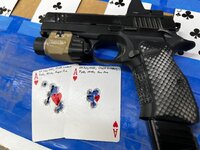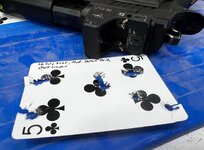I’m a bit hesitant to respond as I do not want this to be an argument, or taken poorly. Most of what you write is spot on, and I don’t want to be rude, but this gives me “WTF, 2002 wants their pistol shooting ideas” back.
I literally laughed out loud when I read this. We're good, no offense taken, and when you put it that way I do actually see where you're coming from, as it did sound pretty 2002.
There are about 0 people under stress that cock the hammer of a DA/SA pistol even when that was an “idea” and trained some places 25 years ago.
The problem here, is that I've done it several times "under stress and on demand", including a 1-round hit on a running coyote at about 60 yards chasing one of my horses I had at the time. Granted, that's certainly not the same thing as being on a 2-way range, but thumbing the hammer for a first-round SA trigger pull is a viable option if you need to make a precision shot with a DA/SA gun, with little time to make it happen. That horse was panicking and was headed for barbed-wire, 5-figure disaster.
Keep in mind that my use of the technique is
context, judgment, and discretion-dependent, at levels that may not be appropriate to ask of a new shooter, or as part of instruction in a 101-level handgun class. I personally would argue that manually engaging SA on an DA/SA gun, however, is a basic-level skill that should be taught from the beginning. I have noticed a couple of times, that when the two of us have disagreed on pistol stuff, that that aspect seems to be in there somewhere - one of us knowing a technique is perfectly valid and viable based on personal, sometimes real-world experience, and the other voicing objection not actually on whether its viable, but whether it's something that is appropriate for newer or lesser experienced shooters.
The front-sight focus vs "soft focus/target focus" thing in another thread is a good example of that, which is related to the point-shooting comment here...
Your use of “point shooting”- I actually don’t know how to respond to that. “Point shooting” at anything other than out of eyeline contact shots
Yes, "point shooting" is antiquated and invalidated term, used as short-hand here - my bad. In this context I meant it within the spectrum of contact-distance shooting, through covering the 2-3 yard target with the back of the slide as an "aiming" method, to the flash-sight-picture at 3-4ish yards, to the soft-focus/semi-focus/front-sight focus out to 5-7 yards, depending on the dynamics of the reality of that moment. Should not have used the discredited term, as it didn't describe what was meant. I'm actually a little embarrassed, as you're right - "point shooting" has been thoroughly discredited.
To my point though, out to 5-7 yards and through that spectrum of aiming solutions - the choice of which is dictated by the immediacy and nature of the threat in that moment - DA isn't handicapping me enough within the time and accuracy needs of that moment to warrant thumbing the hammer. And if the choice beyond 7yds is a possible miss with the first round on DA and just
hope no innocents or property are damaged, or thumb the hammer and execute a CNS shot to end the threat as fast as possible, I'm thumbing the hammer. If I have any degree of the initiative, or if any degree of precision is needed, that gun goes into SA mode manually and is used like any other SA gun. Because I've personally validated it in my own reality, multiple real-world times, twice in very high-stress, high-consequence events.
Now, if you wanted to say that it may not be the best approach to teach a new shooter, there may be some validity to that. But it's highly arguable. You let the mindset craft the skillset around the toolset for the mission and job at hand - so if someone is using a DA/SA gun, when precision is necessary the skillset of thumbing the hammer is a proven and necessary one.
Going all the way back to the advent of DA revolvers. Thumbing the hammer back is just a non-issue, second nature, no-brainer kind of thing. It only seems weird in comparison to other gun designs that came later.
You go DA when you are in point/contact/conversational distances facing immediate violence, but for God's sake, be responsible with your shots with maximum precision any time you are afforded the ability to do so, by going SA. DA is not the
primary mode of fire, it's the "oh $h*t I'm about to die" mode when you have zero time and distance to do anything else, and the initiative has been taken from you. Speed, surprise, and violence of action come with having the initiative, and are SA. "Do you know why I pulled you over today? WAIT OH CRAP DROP THE GUN!" is DA.
But I went away from DA/SA guns because I didn't want to have to f*ck around with all that.
It is simply better to get the best tool for the job, and until some of the SAO designs of the last few years came out, I've simply never found striker-fired guns to be better at making consistent, fast hits from contact-distance to 100 yards better than DA/SA guns. But as a woods gun or edc? I'd take a hammer-fired DA/SA Sig over any striker fired gun I've ever put any time into, save possibly a couple of the P365 variants.
Dude bro, that was just a low-down, dirty ol' below-the-belt mean punch right there, man. *grin*. Besides, ain't no bouncy houses around to practice that patented bob-n'-weave CQB thing they 'teach'.




